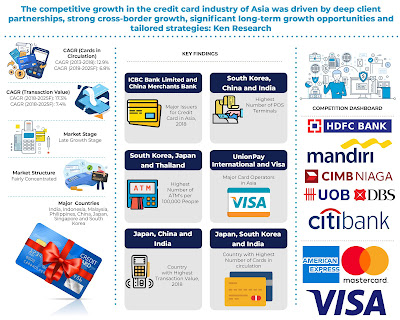Some of the key factors driving growth in the Asia Credit Card Market are digitalization, development of infrastructure (Integration with Artificial Intelligent Platforms, POS Terminals, and ATM Terminals), Improved Member Merchants Discounts, Rewards and Loyalty Programs, Increasing Disposable Income and Reducing Interest Rates.
The Asia credit cards market has been observed to be at a late growth stage. The competitive growth in the credit card industry of Asia was majorly driven by deep client partnerships, strong cross-border growth, long-term growth opportunities, and tailored strategies. The digital payments industry in Asia has scaled up rapidly over the last few years which has led to an increase in credit card usage. The growth is majorly driven by usage among youth and the younger population. About 83.0% of millennials aged 25-34 years use credit cards more than any other age group.
Increasing Digital Payments Industry: The rise of affordable smartphones and sub-sequent internet and mobile penetration has led to significant growth in the digital payments space amongst Asian countries. Users have steadily embraced non-cash methods over the years especially the usage of credit cards.
The introduction of various types of credit cards such as reward-based cards for gaining reward points against shopping, traveling and even filling up the fuel in vehicles has also driven the growth of credit cards. Additionally, the design, as well as the appearance of the credit cards, can be customized as per the user's need. Partnerships with the FinTech will play a crucial role in the development of a digital payments ecosystem by promoting innovation and enabling open-loop payments that promote the adoption of digital payments.
Most of the Asian countries such as India, Indonesia, Malaysia, and others have just started their cashless journey. The countries are highly dependent on cash with the majority of the transactions being made in cash. Asian countries have eliminated many of the typical macro-economic factors to move forward to being a cashless economy; however, low rates of financial inclusion are having an adverse impact on the growth of cashless payments. The role of specific regulatory bodies such as RBI in India and The Peoples Bank of China in monitoring, regulating and promoting digital payments and credit card usage in Asia will have a great impact on the issuance of the credit cards and the transaction value and volume in present and in the future as well. The use of traditional cashless methods such as cheques is on the decline. Cheques are increasingly becoming a US-only phenomenon and will be replaced soon by other payment methods. China, South Korea, and India have recorded a major decrease in cheque usage.
Analysts at Ken Research in their latest publication “Asia Credit Cards Market Outlook to 2025 – By Commercial and Personal Credit Cards; by Transactions at ATM and POS terminals; by Total Cards in Circulation; by Transaction Value and Volume through issuers & operators; and By Major Countries (Japan, South Korea, India, China, Indonesia, Philippines, Singapore, and Others)” believe that the Asian credit card the market will increase owing to the rising millennial population and the growth in the technology and FinTech in the all the Asian countries. This rise is expected to boost the demand for credit card products and services in Asia owing to the requirement of both personal as well as commercial credit cards. The market is expected to witness a forecasted CAGR of 6.8% in terms of total cards in circulation and a CAGR of 7.4% in terms of the total transaction value for the period 2018-2025.
Key Segments Covered:-
Credit cards
Value of transaction by Issuer and Operator
Volume of the transaction by Issuer and Operator
Number of Credit Cards in Circulation by Issuer and Operator
Commercial and Personal Credit Cards
Transactions at ATM and POS
Countries
India
Indonesia
Malaysia
Singapore
Philippines
South Korea
China
Japan
Other Countries (Vietnam, Thailand, Hong Kong, Taiwan and Rest)
Key Target Audience
Credit/ Debit Card Operator
Credit/ Debit Card Issuers
Prepaid Card Issuers/ Operators
Local/ Foreign Bank
Reward/ Loyalty Program Business Operators
Payment gateway provider
Credit/ Debit Card Issuer
POS Device Manufacturers
Debit/ Credit Card Manufacturing companies
ATM Manufacturing Entities
Regulatory Authorities
Time Period Captured in the Report:-
Historical Period: 2013-2018
Forecast Period: 2018-2025
Companies Covered in Asia Credit Card Market:-
Banks (Issuer)
HDFC, India
Bank Mandiri, Indonesia
Bank CIMB Niaga, Indonesia
UOB, Singapore
DBS, Singapore
Citibank Bhd, Malaysia
Malaysian Banking, Malaysia
Shinhan Card, South Korea
KB Kookmin, South Korea
BDO Unibank, Philippines
Metropolitan Bank, Philippines
ICBC Bank, China
China Merchants Bank, China
JCB, Japan
Credit Saison, Japan
Others (SBI India, Bank CIMB Niaga Indonesia, Bank Mega, Citibank, HSBC Holdings Plc, Rizal Commercial Banking CORP (RCBC) and Rest)
Operators
Visa Inc.
MasterCard
American Express
Bank Central Asia
Union Pay International
Others (Shinhan Card, BC Card, Petron Corp, Taiwan Rakuten Card and Rest)
Key Topics Covered in the Report:-
Major Credit Card Issuers in Asia
Future of Credit Cards in Asia
Credit Card Market Forecast Hong Kong
Taiwan Credit Cards Market Growth Rate
Expected Credit Cards in Circulation Asia
Number of American Express Cards in Asia
Number of Union Pay International in Asia
Demonetization Impact on India Credit Card Industry
Market Report on Credit Cards Asia
Asia Payment Services Market
Asia Credit Cards Market Transaction Value in USD Million
Contactless Credit Card Holders in Asia
Credit Cards in Circulation in Asia
Credit Card Transaction at ATM in Asia
Credit Card Transactions at POS Terminals
For Information Click On the Below Mentioned Link:-
Related Reports by Ken Research:-
Contact Us: -
Ken Research
Ankur Gupta, Head Marketing & Communications
+91-9015378249




